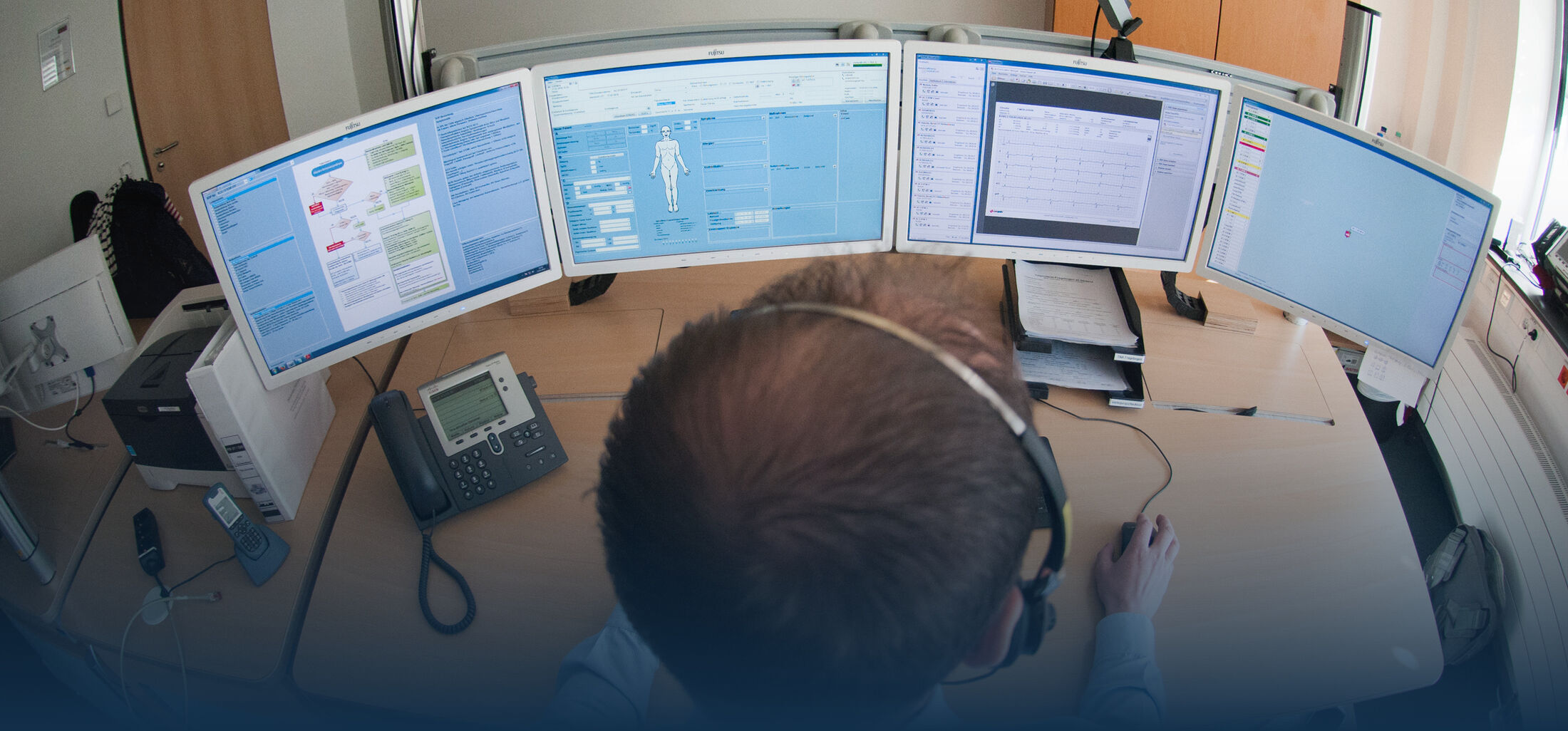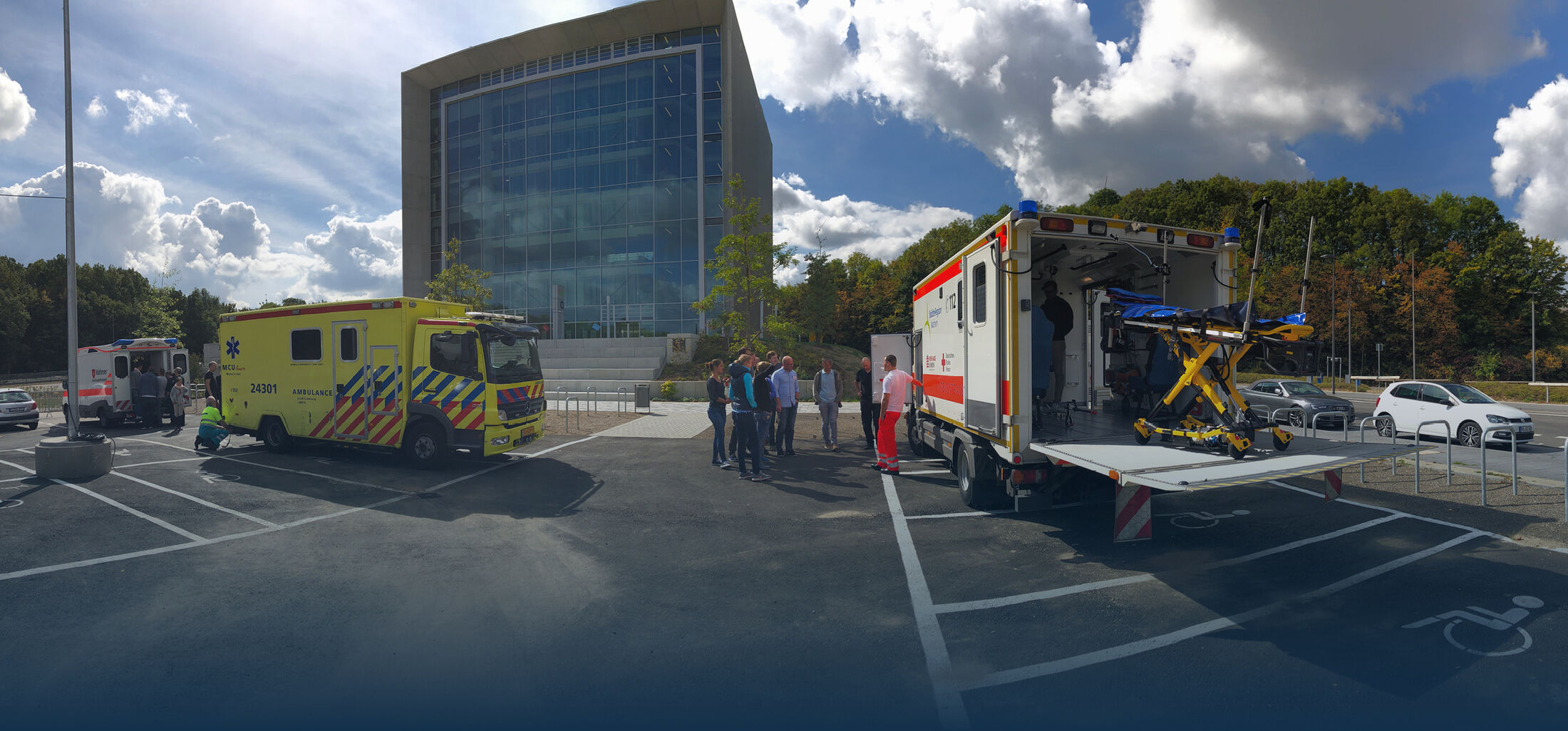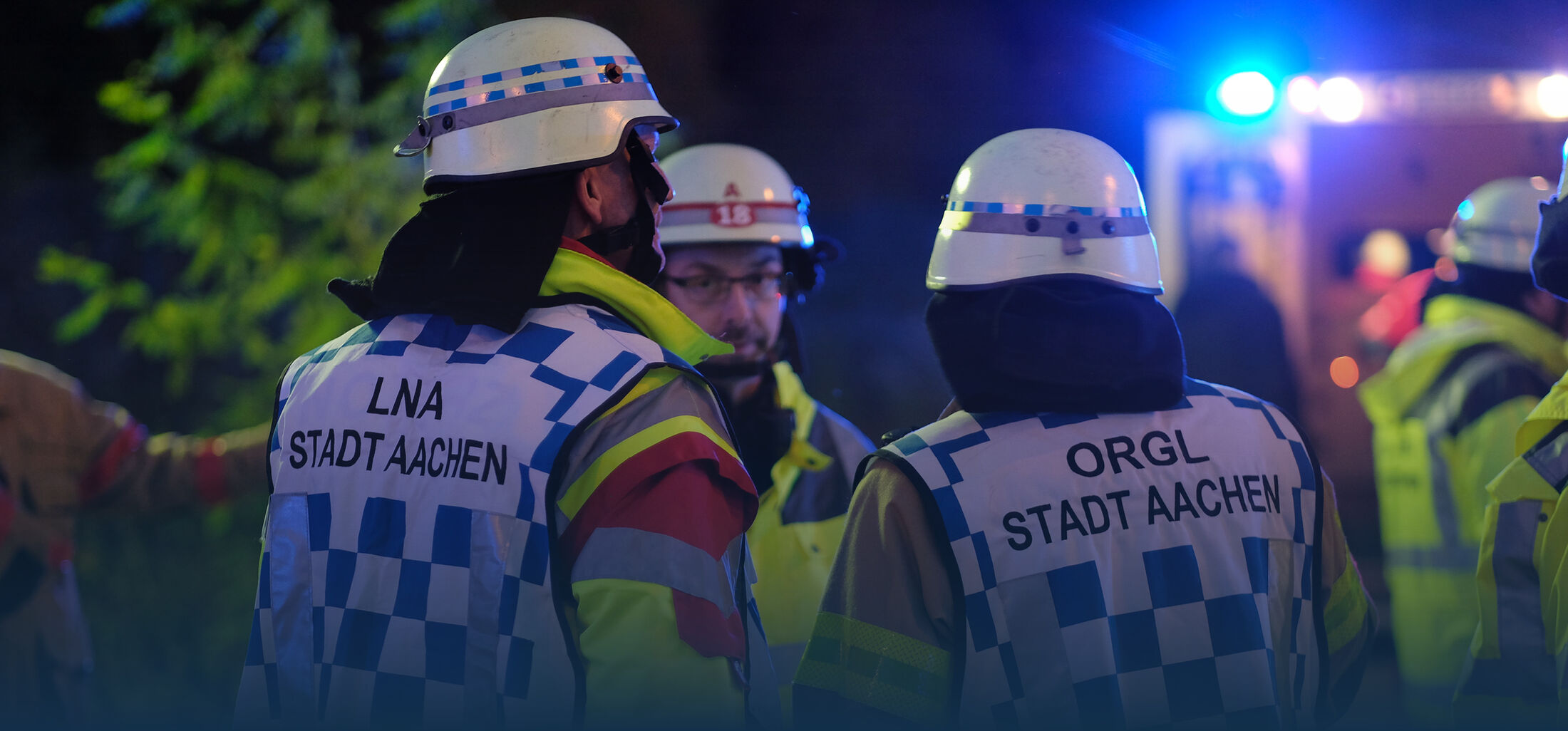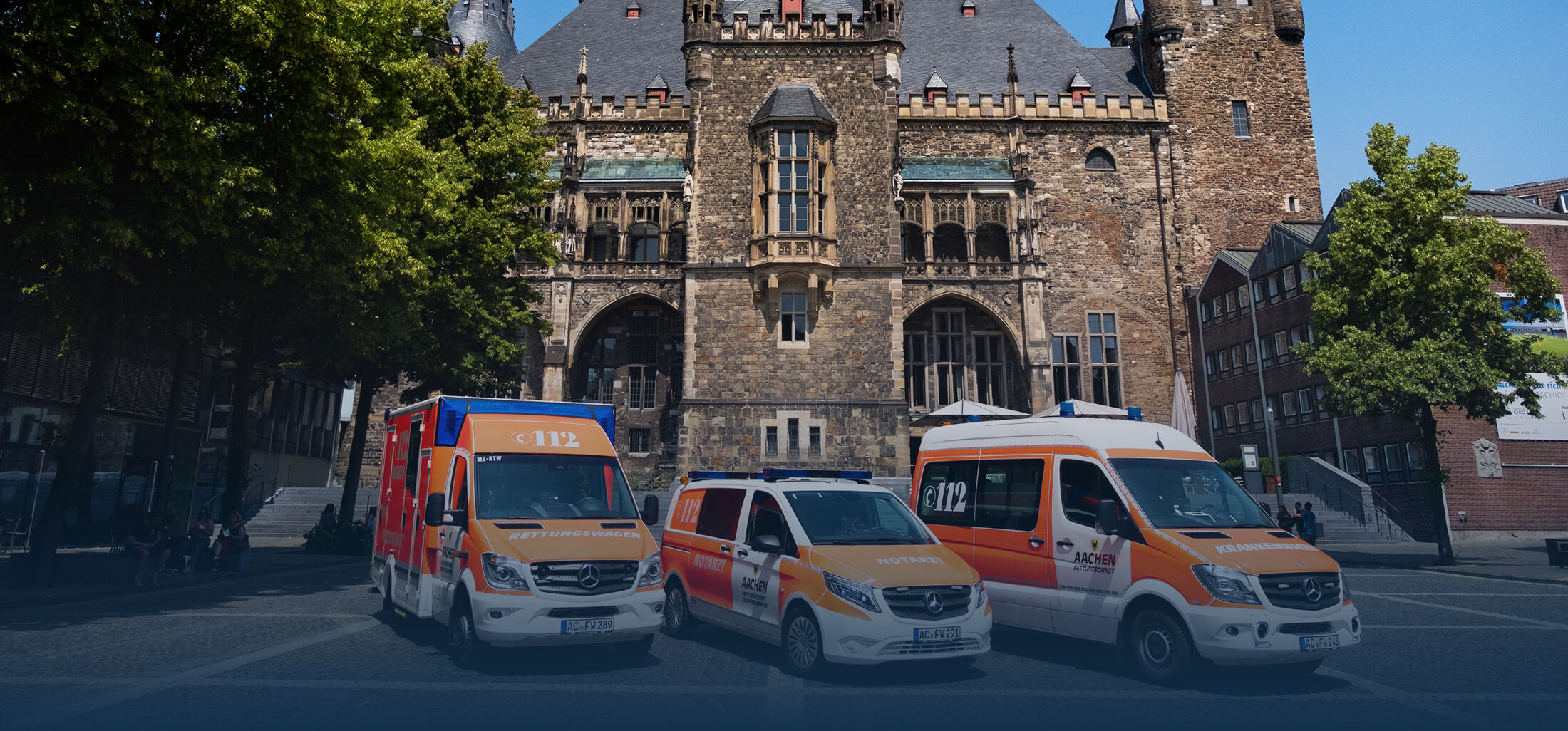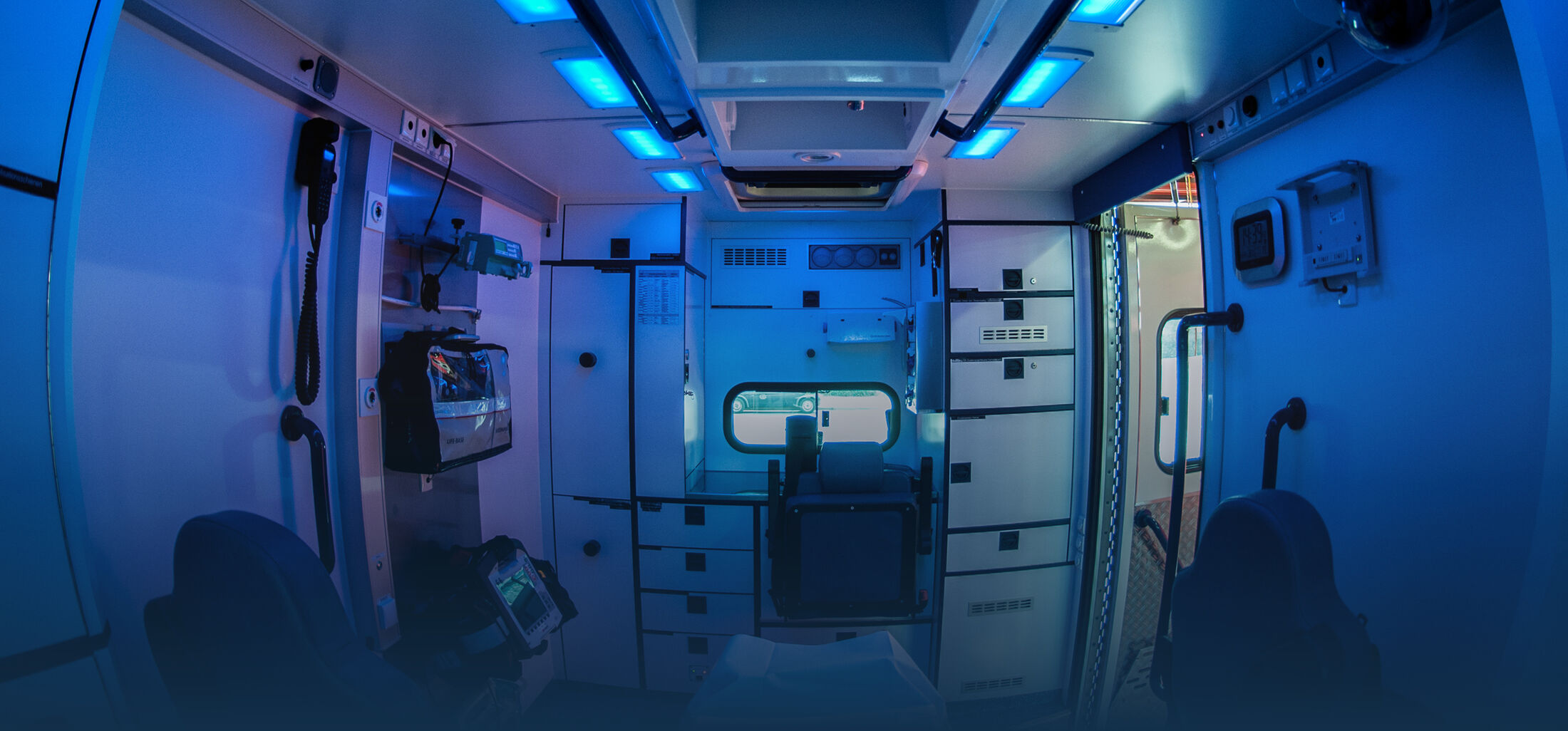FAQ Tele-emergency physician
All secondary transportations, assigned by the emergency physician, are being screend by the tele-emergency physician. The standard procedure acquires the tele-emergency physician to communicate with involved physicians of the transferring hospital.
The tele-EMS service in Aachen was created from two publicly funded research projects, Med-on-@ix 2007-2010 (BMWi) and TEMRAS 2010-2013 (Ziel-2 NRW). The research consortium consisted of the University Hospital RWTH Aachen, various institutes of the RWTH Aachen, and the engineering companies P3 and Philips.
After finishing the research phase, the tele-EMS service was transferred to the regular rescue service. Since then it was maintained by P3 (now Umlaut AG) as as the main operator.
Today, the tele-EMS system is considered an additional rescue tool in the demand planning and is refinanced by the health insurance companies.
In order to meet the special quality requirements for tele-medically supported emergency operations, only particularly experienced emergency doctors who meet the following requirements are employed as tele-EMS physicians:
- Specialist in anaesthesiology or specialist standard (at least 5th year of further training)
- Extensive experience in emergency medical services (over 500 deployments)
- Additional certification in emergency medicine of a medical association
- Proof of a certified standard of care in resuscitation care (Advanced Life Support (ALS) provider course, e.g. of the ERC)
- Proof of a certified standard of care in trauma care (e.g. Pre-Hospital Trauma Life Support (PHTLS) Provider Course
All Tele-EMS physicians are specifically prepared for their work with the help of a structured induction concept and instructed to technical, organisational, and medical details. The concept is focused on the structured use of evidence-based procedural instructions, which are made available to the tele-EMS physician in a context-sensitive manner via software.
The tele-EMS physicians regularly participate in advanced training for doctors according to the latest guidelines and recommendations (at least once a year). In addition, all emergency doctors in NRW must complete 20 hours of pecialized training in rescue services within two years, in accordance with the NRW Rescue Services Act §5 Paragraph 4 Sentence 2. Moreover, each tele-EMS physician is supervised at least every three months by an experienced tele-EMS physician.
Most of the tele-EMS physicians are employed at the University Hospital RWTH Aachen and additionally engage in EMS. They all meet the above-mentioned locally defined standards. Doctors from other hospitals in the region are also allowed to participate in the tele-EMS service. All tele-EMS physicians continue to work in the ground-based emergency medical service.
Primary tasks of the tele-EMS system depending on emergency scenario
Emergency response without emergency physician
After taking the patient's medical history and after first aid, the ambulance team contacts the tele-EMS physician if necessary. The tele-EMS physician is contacted for consultation and/or approval of a defined standard therapy in accordance with procedural instructions. This includes the appropriate administration of medication. If the ambulance team and the tele-EMS physician jointly come to the decision that an emergency doctor is required on site, this will be requested immediately.
Emergency response with emergency doctor (before emergency doctor is on site)
- The ambulance team contacts the tele-EMS physician after taking the patient's medical history and initial treatment has been completed if the arrival of the emergency doctor on site is delayed (e.g. due to different travel routes, or if the emergency physician is temporarily unavailable).
- Before the emergency physician arrives on site, the tele-EMS physician can provide consultation and/or approval of a defined standard therapy according to procedural instructions. This includes an appropriate administration of medication, hence ensuring early treatment also in life-threatening situations.
Emergency response with emergency physician (support of the emergency physician on site)
- The emergency physician on site contacts the tele-EMS physician after taking the patient's medical history and starting initial treatment. In this case, the tele-EMS physician can support and advise the emergency physician on-site on various issues (e.g. contacting the emergency poison centre, complex ECG diagnostics, therapy decisions, differential diagnoses, decision on the choice of the target hospital / specialist department, contact with the most appropriate destination hospital, activation of the ECMO (Extra-Corporal Membrane Oxygenation (Heart-Lung-Machine)) team of the university hospital) etc.
Secondary tasks of the tele-EMS physician
Advice to the dispatch centre
Advice and support for staff at the dispatch centre on medical issues of the rescue service in their daily operations.
Medical coordination of secondary transports
The tele-EMS physician takes over the medical coordination of secondary transports. All registered secondary transports that contain a request to an accompanying emergency doctor are screened by the tele-EMS physician. A physician-to-physician consultation takes place between the tele-EMS physician and the attending physician of the delivering hospital for standardised recording of the patient's condition and the transport requirements.
- The tele-EMS physician decides which means of transport is required for secondary transport. In addition to standard ambulance transfers and emergency-doctor-assisted intensive care transfers, patients who meet the criteria for tele-EMS physician accompaniment can be transported by an ambulance with additional monitoring by a tele-EMS physician. This way, pain therapy or other medication required during the transport can be administered.
- Approximately one third of all doctor-supported emergency operations are supported by a tele-EMS physician in the current area of operation.
- More than 36% of all physician-assisted transfer transports are now overseen by a tele-EMS physician.
- The doctor-free time interval, until a "conventional" emergency physician arrives, can be shortened by meanwhile consulting the tele-EMS physician.
- The tele-EMS physician allows a high quality of documentation and a high level of guideline adherence in emergency care.
- Time-shifted parallel operations are possible by applying the appropriate prioritisation (currently in 15-20% of cases)
- The total duration of the tele-EMS physician's intervention in an emergency is 50% shorter than that of a "travelling" emergency physician. In particular, the net commitment time (time spent talking to the team) during the deployment is significantly shorter for the tele-EMS physician.
- The tele-EMS physician is even more efficient when used nationwide in a joint tele-EMS system ambulance network.
A mobile transmission unit is the centerpiece of the tele-EMS physician system and enables secure and reliable voice and data communication via three different mobile radio networks from the deployment site to the tele-EMS physician centre.
- The ambulance team on site can easily contact the tele-EMS physician by pushing a button on a headset
- Real-time transmission of the patient's vital parameters via mobile network to the tele-EMS physician
- Sending photos (of medications or doctor’s letters) from deployment site to the Tele-EMS physician
- Transmission of video material from the ambulance via HD ceiling camera
- Printout of the tele-EMS physician's protocol in the ambulance as well as the possibility of digital pre-registration for a certain hospital
Yes. In two legal opinions commissioned during the research phase, all essential legal questions and problems were answered.
Expert opinions:
- Prof Dr iur. Christian Katzenmeier (Institute for Medical Law, University of Cologne)
- Prof Dr Karsten Fehn (specialist lawyer for medical law, Cologne University of Applied Sciences)
The evaluation considered the following issues:
- Privacy
- Principles of personal service provision
- Prohibition of remote treatment liability issues / criminal responsibilities
- Telemedical delegation of medical measures
The legal certainty has since been strengthened by the Emergency Paramedics Act and has been taken up and confirmed in the context of rescue service laws at state level (most recently in Bavaria - decree of the Ministry of the Interior).
- The tele-EMS system increases the legal security for all parties involved during the teleconsultation
- The tele-EMS physician assumes the overall medical responsibility for each case accepting a call.
- Measures and medication delegated by the tele-EMS physician are not subject to emergency competence
- The responsibility for the implementation of medical measures remains with the paramedics, just as in conventional emergency medical operations
- The teleconsultation does not violate the prohibition of remote treatment
